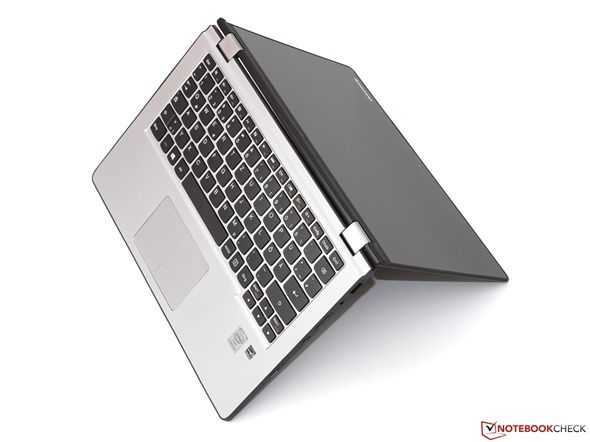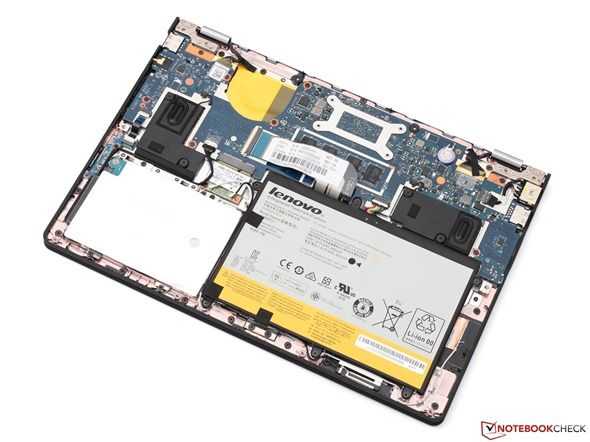The Yoga 2 11 isn’t just a Yoga-for-the-masses or an Ultrabook without the sticker. It’s a look into the future of Ultrabooks
It’s a fanless, lightweight, convertible, touchscreen Windows PC and costs under 600 Euro. It’s the latest incarnation of the Lenovo Yoga 11 Ultrabook but it’s running a Baytrail processor. There’s four cores instead of two, and no fan. There’s a USB3.0 connector and a total weight of just 1.45KG. This is looking like a pretty smart 2-in-1. Notebookcheck have just given it an 80% rating in their review.
600 Euro isn’t exactly mainstream pricing for a little notebook. The Lenovo Ideapad Flex 10, a slightly smaller but lighter Baytrail-M (N3520) based laptop with ‘tent mode’ and touch is under 300 Euro but I would expect that 600 Euro to drop by 10-25% fairly quickly and for short-term offers to appear around 450 in the future.
In the detailed review at Notebookcheck we see that it has a 500GB HDD inside. Of course I’m immediately thinking of SSD upgrade possibility here but it’s a 5mm 2.5” SATA drive so options are limited. The performance of the Celeron Baytrail-M CPU is better than the one I’ve just tested on the Intel NUC so it’s in an acceptable area but the user experience would be vastly improved with an SSD.
A 35Wh battery returns about 5 hours of web-usage.
A fanless, lightweight, convertible touchscreen notebook at a consumer-friendly price is, in my opinion, exactly what the market needs in order to make notebooks interesting again. The Lenovo Yoga 2 11 shows some weaknesses in the processor department and a higher-resolution display would be appealing but this is still a capable device and with an SSD upgrade (and a $100 discount to pay for it!) could be a real winner.













I really don’t see the point in convertibles; they’re way too clunky and heavy to use as a tablet. The only advantage I see that this has over the (much cheaper) detachables is that it has a SATA drive so you can add a real SSD. And I see the RAM is soldered so that’s not even upgradable, and you didn’t mention it so I bet it’s 2GB. Also, it’s not an ultrabook because it has an atom CPU.
Aren’t detachables convertibles too? The review also says the soldered RAM is 4 GB.
Anyway, I agree but I also include the smaller detachable convertibles in the not that great category. Even if they make it as light as an iPad Air (I have one collecting dust somewhere), 10+ inch screened tablets with their usual large bezels for holding purposes are too awkward to use. They’re easier to use on a table or lap but then you might as well use the notebook/clamshell form factor.
I remember Chippy having an article that tried to highlight the use cases for a touch screen on a notebok/clamshell form factor. It wasn’t very convincing. So for a 10+ inch device, I’d rather get a notebook form factor and have the option to not include a touch screen if it’s cheaper.
8″ and smaller screens are more convenient for the scenarios I’d personally use a tablet. Non-table/non-lap use is easier with smaller tablets. Smaller tablets take up less space when I travel where my bag is dominated more by travel stuff than electronics. When I need a keyboard, mouse and larger screen, I’d dock it but that would be rare.
Convertibles fold, detachables separate. Good it has 4GB, might fill some niche after all, still overpriced.
@10 vs 8:
10″ detachables offer a tablet/notebook compromise that is better than separate devices. Mostly used as a notebook, but tablet mode when curled up on a sofa or in bed. All files/programs/settings in one place. IE11 is best touch browser- what I mostly use a tablet for, and W8/modern multitasks best too.
OTOH 8″ tablets sacrifice notebook use for better tablet functionality, but can do tablet/desktop. I love the portability; carry around your ‘desktop’ in a coat pocket. Sadly none of these really work properly in a docked desktop mode yet (powered, connect USB(3) devices and native screen connection). They should be awesome once the USB3.1/C-connector is available with them.
So where you lie on the 8″ VS 10″ to me depends on if you want (to use it as) a notebook, or are happy being productive in just one place. Both devices desperately need affordable 4GB offerings to really be useful as a sole notebook/desktop, ideally faster storage too.
I believe touch screens will (and should) become default on notebooks. The cost is tiny. Like webcams and microphones exist on all notebooks– I rarely use them, but nobody complains they’re there. OEMs are just using touch screens as a way to differentiate as a premium product, but that won’t last forever; they will stop charging for them and stop making SKUs without them.
I agree that it’s overpriced. Would be better if you could upgrade the ram. I do like convertibles though, even if they are a bit bigger then detachables.